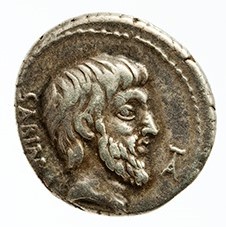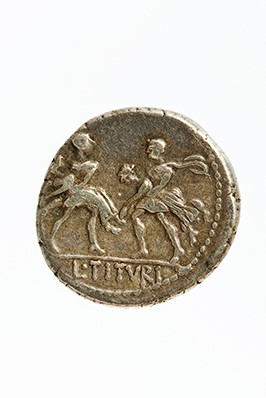Title: Denarius of L. Titurius Sabinus - 1985.09
Acquisition number: 1985.09
Author or editor: Beryl Rawson
Culture or period: Roman Republic
Date: 89 BC
Material: Metal - Silver
Object type: Coins - Roman
Dimensions: 16mm (w)
Origin region or location: Italy
Origin city: Rome
Display case or on loan: 5
Keywords: Coin, denarius, Roman, Republic, King Tatius
Sear, D.R., Roman Coins and their Values 5 vols (London, Spink, 2000-2014) 249; Crawford, M., Roman Republican Coinage 2 vols (Cambridge, Cambridge University Press, 2011) 344/1A-B; Sydenham, E. A. The Coinage of the Roman Republic (London, Spink, 1952; (Sanford J. Durst repr. 1976) 698, 698A; Seaby, H.A., Roman Silver Coins (London, B.A. Seaby, 1967) Tituria 1-2.
1985.09
Denarius of L. Titurius Sabinus
3.84 g. 89 BC
Obv.: Bearded head of King Tatius r. behind, SABIN; in front, control symbol.
Rev.: Two Roman soldiers each carrying off a Sabine woman: the ‘rape of the Sabine women’. L. TITVRI in exergue.
The seizure of the Sabine women in Rome is one of the early legends of Rome. It is attributed to the early period of Romulus’ rule, soon after the founding of Rome (traditional date 753 BC). According to the legend, the Romans needed to increase their female population to ensure the future of their new city. After failing to negotiate any marriage alliance with other cities, they captured Sabine women by a ruse. They had invited Sabines (men, women and children) to games in Rome, where they captured the young Sabine women from their unarmed fellow-citizens. War followed, which was ended when the Sabine women, now wives of Romans and mothers of their children, intervened between Sabines and Romans and brought about a reconciliation. Part of the settlement involved making the Sabine King Tatius co-ruler with Romulus. (This arrangement did not last long, because of the early death of Tatius.)
Whether or not Titurius' cognomen Sabinus indicates Sabine origin for him is disputed, but he chose Sabine associations for some of the types on the coins which he minted as moneyer in 89 BC. This was a time of strong regional loyalties, with Rome's Italian allies in revolt against Rome (the ‘Social War’) to obtain greater political rights; but the Sabines had had full citizenship for centuries. Another Sabine type on Titurius’ coins was that of the killing of Tarpeia, a Roman woman who admitted Sabines to the Capitoline Hill during their war with Rome. Rather than rewarding her, the Sabines killed her for her treachery, and the place of her death, the Tarpeian Rock, was subsequently the site for the death of traitors and other criminals.
Livy’s account (1. 9) of the seizure of the Sabine women tends to be admiring of the Romans' ruse rather than condemnatory of any ‘rape’, and the use of the legend on Roman coins suggests that it was not necessarily seen as a negative episode.
Sear, D.R., Roman Coins and their Values 5 vols (London, Spink, 2000-2014) 249; Crawford, M., Roman Republican Coinage 2 vols (Cambridge, Cambridge University Press, 2011) 344/1A-B; Sydenham, E. A. The Coinage of the Roman Republic (London, Spink, 1952; (Sanford J. Durst repr. 1976) 698, 698A; Seaby, H.A., Roman Silver Coins (London, B.A. Seaby, 1967) Tituria 1-2.

